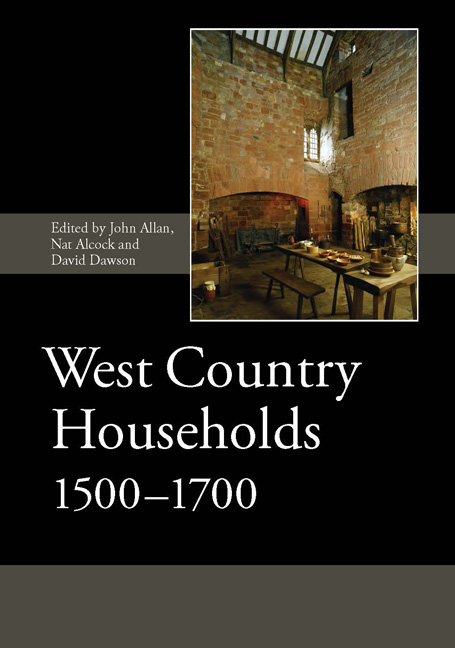Book contents
- Frontmatter
- Dedication
- Contents
- List of Illustrations
- List of Contributors
- List of Abbreviations
- Introduction
- I The Form and Development of West Country Houses
- 1 The Development of the Vernacular House in South-West England, 1500–1700
- 2 The Transformation of the Building Stock of Exeter, 1450–1700
- 3 The Appearances of Godolphin, Cornwall, c. 1300–c. 1630
- 4 Boiling Furnaces, Smoking Chambers and Malt Kilns in West Country Households
- II The Decoration of West Country Houses
- III The Material Culture of West Country Households
- Index of People and Places
- Index of Subjects
2 - The Transformation of the Building Stock of Exeter, 1450–1700
from I - The Form and Development of West Country Houses
Published online by Cambridge University Press: 05 May 2015
- Frontmatter
- Dedication
- Contents
- List of Illustrations
- List of Contributors
- List of Abbreviations
- Introduction
- I The Form and Development of West Country Houses
- 1 The Development of the Vernacular House in South-West England, 1500–1700
- 2 The Transformation of the Building Stock of Exeter, 1450–1700
- 3 The Appearances of Godolphin, Cornwall, c. 1300–c. 1630
- 4 Boiling Furnaces, Smoking Chambers and Malt Kilns in West Country Households
- II The Decoration of West Country Houses
- III The Material Culture of West Country Households
- Index of People and Places
- Index of Subjects
Summary
This paper explores the manner in which the townscape of Exeter changed between the late Middle Ages and the beginning of the 18th century. Topographical sources, archaeological records and extant structures are examined to illustrate the city's range of building types, and to consider how these structures were altered and renewed. The subdivision of properties, stacking of additional storeys on earlier houses and encroach- ments on vacant land are described; a dramatic growth in the city's population is seen as a major factor in this change.
INTRODUCTION
In the late 19th century Exeter was an exceptionally well-preserved historic city. Although it had been one of the five or six leading towns of England throughout the 16th and 17th centuries, its decline in status and wealth after c. 1720, accompanied by the steady departure of wealthy citizens from its centre, precluded extensive Georgian and Victorian replacement of its old buildings. Within its circuit of Roman and medieval walls and in the historic suburbs its streets therefore retained numerous closely packed ancient houses, ranging from the large clergy mansions of Cathedral Close to tiny cottages in the industrial districts by the river or crammed into narrow courts off the main streets. It was famous for the beauty of its historic architecture but notorious for the vileness of its slums, these qualities sometimes being embodied in the same buildings.
Since then, few areas of the old city have escaped slum clearance, Blitz damage or redevelopment schemes, and the majority of its ancient buildings have been demolished. Fortunately Exeter is richly documented in early topographical drawings, engravings and photographs. It has also been the subject of much detailed modern building recording, which has shown that far more historic fabric survives than is apparent upon casual inspection. The work of Portman, a pioneering study of the early modern houses of an English provincial town when it was published in the 1960s, has been followed by a sustained programme of recording by Exeter Archaeology, begun in 1971 and still active, much of it undertaken during alteration or demolition.
- Type
- Chapter
- Information
- West Country Households, 1500–1700 , pp. 35 - 68Publisher: Boydell & BrewerPrint publication year: 2015



